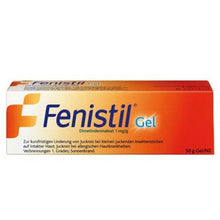Fenistil Gel 0.1%, 50 g, Gsk
Therapeutic action:
Dimethindene maleate, a phenindene derivative, is an H1 receptor antagonist. Consequently, it reduces capillary hyperpermeability following immediate hypersensitivity reactions. Fenistil gel is effective in all forms of pruritus, except cholestatic and combats skin irritation. The excipient, an odorless and colorless aqueous gel, potentiates the properties of the active principle and ensures a good skin penetrability.
Pharmacokinetic properties:
Fenistil gel penetrates the skin quickly, and the antihistamine effect is installed in a few minutes, with a maximum of 2-4 hours. The metabolism of the active substance includes hydroxylation and methoxylation. Dimethindene and its metabolites are predominantly excreted in bile and urine, only 5-10% in unchanged form.
Indications:
Itching in dermatoses, urticaria, insect bites, sunburn, mild superficial burns.
Method of administration:
Usual dosage: 2-4 daily applications. Administration in special cases: for severe pruritus or extensive lesions, topical treatment with Fenistil gel is associated with systemic therapy with Fenistil retard, Fenistil dragees or drops.
Contraindications:
Hypersensitivity to one of the components.
Precautions:
Avoid prolonged sun exposure of treated areas. In infants and young children, avoid using Fenistil gel on large areas or on skin lesions and inflammation.
Pregnancy and lactation:
Animal studies do not indicate any fetal risk, but no human data are available. However, avoid applying Fenistil gel in the first 3 months of pregnancy. Fenistil gel is recommended not to be applied on large areas or on skin lesions or inflammation. Similar precautions are taken during breastfeeding (although studies have shown an insignificant amount in breast milk after local applications), when it is forbidden to apply Fenistil gel on the nipples.
Side effects:
Rarely, signs of mild transient local irritation, such as dry skin or burning sensation. Hypersensitivity reactions occur very rarely.
Interactions:
To date, no interactions of Fenistil gel with other drugs have been observed.
Overdose:
No cases of overdose with Fenistil gel have been reported to date. However, the application of Fenistil gel on large areas or on lesions, as well as the accidental ingestion of a large amount can cause symptoms of overdose with antihistamines: drowsiness, arousal, ataxia, tachycardia, hallucinations, tonic or clonic spasms, mydriasis, dry mouth, urinary retention, fever, hypotension. No fatal cases of Fenistil gel poisoning have been reported. There is no specific antidote for antihistamine overdose. Emergency measures consist of: inducing vomiting, gastric lavage when vomiting is ineffective, administration of activated charcoal, saline laxatives and, when necessary, cardiorespiratory assistance. The use of stimulants is not recommended.
Presentation:
50 g




